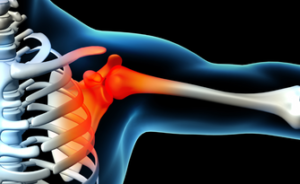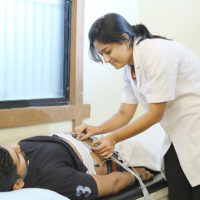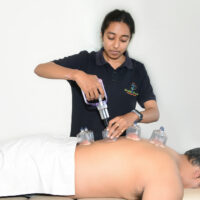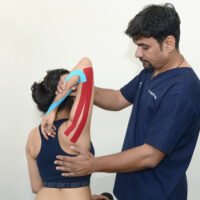Shoulder pain is a common problem that can be caused by various factors. It can range from mild discomfort to severe pain and can limit the range of motion in the shoulder joint
Shoulder Pain
A rotator cuff injury can occur due to a sudden traumatic event, such as a fall or lifting a heavy object, or due to gradual wear and tear over time.
Common symptoms of a rotator cuff injury include pain, weakness, and limited range of motion in the shoulder. In severe cases, a rotator cuff tear may require surgical intervention, while less severe cases may be treated with rest, physical therapy, and pain management techniques.
- While lifting heavy objects, use your legs and core muscles instead of straining your shoulders. Lift with proper form, keeping the object close to your body, and avoid twisting motions while lifting.
- Gradually increase intensity, sudden increases in activity level can place excessive stress on the rotator cuff muscles and lead to injury. Allow your muscles and joints time to adapt and strengthen.
- Warm up and stretch before engaging in any physical activity or exercise.
- Maintain good posture and use proper body mechanics during everyday activities and exercises.
- Use proper techniques during sports and activities.
- Avoid excessive overhead lifting or reaching, Minimize excessive overhead lifting or reaching movements, especially when combined with forceful or repetitive actions.
- Maintain a healthy lifestyle

Frozen Shoulder
Frozen shoulder, also known as adhesive capsulitis, is a condition characterized by stiffness and pain in the shoulder joint.
The exact cause of frozen shoulder is not fully understood, but it is believed to be related to an inflammation of the joint capsule, which leads to the formation of scar tissue. This scar tissue can cause the joint capsule to thicken and tighten, making it difficult to move the shoulder.
Symptoms of frozen shoulder include a gradual onset of pain and stiffness in the shoulder joint. The pain may be worse at night and can limit the range of motion in the shoulder. In severe cases, the shoulder may become completely “frozen” and immobile.
- Regularly perform shoulder exercises and stretches to maintain the mobility and flexibility of your shoulder joint
- Avoid prolonged immobilization
- Maintain good posture to minimize stress on the shoulder joint. Sit and stand up straight, keeping your shoulders relaxed and aligned with your spine.
- When lifting heavy objects, use proper techniques to avoid excessive strain on your shoulder joint.
- Excessive or repetitive overhead movements can increase the risk of developing a frozen shoulder.
- If you’re starting or increasing an exercise routine involving the shoulder joint, do so gradually. Sudden, intense activities can strain the shoulder and increase the risk of developing a frozen shoulder.

Tendinitis
Tendinitis of the shoulder can be caused by overuse or repetitive motions, such as throwing a ball or performing overhead activities. It can also be caused by an injury or trauma to the shoulder.
Symptoms of shoulder tendinitis may include pain and tenderness in the shoulder, especially when reaching overhead or lifting objects. The pain may also be present at night and can cause difficulty sleeping. The affected shoulder may also feel weak or have limited mobility.
- While lifting heavy objects, use your legs and core muscles instead of straining your shoulders. Lift with proper form, keeping the object close to your body, and avoid twisting motions while lifting.
- Gradually increase intensity, sudden increases in activity level can place excessive stress on the rotator cuff muscles and lead to injury. Allow your muscles and joints time to adapt and strengthen.
- Warm up and stretch before engaging in any physical activity or exercise.
- Maintain good posture and use proper body mechanics during everyday activities and exercises.
- Use proper techniques during sports and activities.
- Avoid excessive overhead lifting or reaching, Minimize excessive overhead lifting or reaching movements, especially when combined with forceful or repetitive actions.
- Maintain a healthy lifestyle

Impingement Syndrome
Shoulder impingement can be caused by a variety of factors, including repetitive overhead motions such as throwing a ball or painting, as well as poor posture or shoulder mechanics. It is also more common in people who are over 40 years old, and in those who have certain medical conditions such as diabetes or thyroid disorders.
Symptoms of shoulder impingement may include pain in the shoulder that worsens with overhead movements, as well as weakness or limited range of motion in the shoulder. The pain may also be present at night and can cause difficulty sleeping.
- While lifting heavy objects, use your legs and core muscles instead of straining your shoulders. Lift with proper form, keeping the object close to your body, and avoid twisting motions while lifting.
- Gradually increase intensity, sudden increases in activity level can place excessive stress on the rotator cuff muscles and lead to injury. Allow your muscles and joints time to adapt and strengthen.
- Warm up and stretch before engaging in any physical activity or exercise.
- Maintain good posture and use proper body mechanics during everyday activities and exercises.
- Use proper techniques during sports and activities.
- Avoid excessive overhead lifting or reaching, Minimize excessive overhead lifting or reaching movements, especially when combined with forceful or repetitive actions.
- Maintain a healthy lifestyle

Arthritis
The two most frequent kinds of arthritis that affect the shoulder are osteoarthritis and rheumatoid arthritis. Both result in shoulder muscle weakness, making it difficult to execute daily tasks.
Rheumatoid arthritis is an autoimmune disease that causes the immune system to target the membranes that surround the shoulder joint. Discomfort and inflammation are symptoms of this illness.
- Regularly perform shoulder exercises and stretches to maintain the mobility and flexibility of your shoulder joint
- Avoid prolonged immobilization
- Maintain good posture to minimize stress on the shoulder joint. Sit and stand up straight, keeping your shoulders relaxed and aligned with your spine.
- When lifting heavy objects, use proper techniques to avoid excessive strain on your shoulder joint.
- Excessive or repetitive overhead movements can increase the risk of developing a Arthritis
- If you’re starting or increasing an exercise routine involving the shoulder joint, do so gradually. Sudden, intense activities can strain the shoulder and increase the risk of developing a arthritis

YOUR NEXT STEPS!
-
Request An Appointment
-
Find the Root Cause and Receive A Custom Treatment Plan
-
Monitor Progress
-
Recover & Get Back to Life!





















